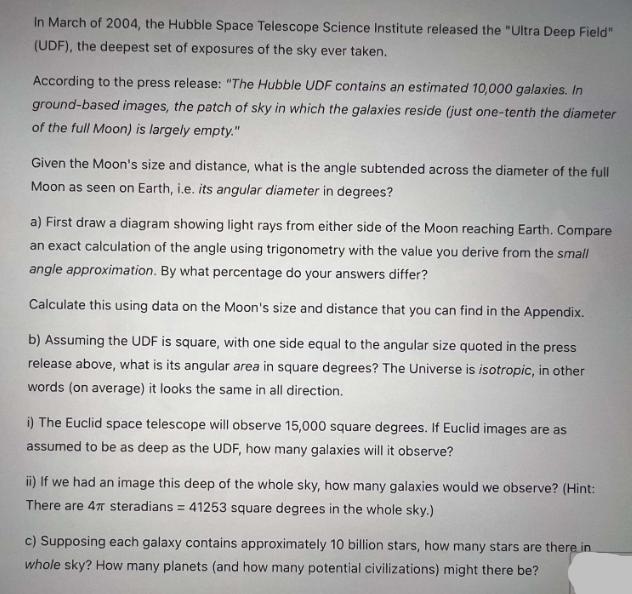Answered step by step
Verified Expert Solution
Question
1 Approved Answer
In March of 2004, the Hubble Space Telescope Science Institute released the Ultra Deep Field (UDF), the deepest set of exposures of the sky

In March of 2004, the Hubble Space Telescope Science Institute released the "Ultra Deep Field" (UDF), the deepest set of exposures of the sky ever taken. According to the press release: "The Hubble UDF contains an estimated 10,000 galaxies. In ground-based images, the patch of sky in which the galaxies reside (just one-tenth the diameter of the full Moon) is largely empty." Given the Moon's size and distance, what is the angle subtended across the diameter of the full Moon as seen on Earth, i.e. its angular diameter in degrees? a) First draw a diagram showing light rays from either side of the Moon reaching Earth. Compare an exact calculation of the angle using trigonometry with the value you derive from the small angle approximation. By what percentage do your answers differ? Calculate this using data on the Moon's size and distance that you can find in the Appendix. b) Assuming the UDF is square, with one side equal to the angular size quoted in the press release above, what is its angular area in square degrees? The Universe is isotropic, in other words (on average) it looks the same in all direction. i) The Euclid space telescope will observe 15,000 square degrees. If Euclid images are as assumed to be as deep as the UDF, how many galaxies will it observe? ii) If we had an image this deep of the whole sky, how many galaxies would we observe? (Hint: There are 4 steradians = 41253 square degrees in the whole sky.) c) Supposing each galaxy contains approximately 10 billion stars, how many stars are there in whole sky? How many planets (and how many potential civilizations) might there be?
Step by Step Solution
There are 3 Steps involved in it
Step: 1

Get Instant Access to Expert-Tailored Solutions
See step-by-step solutions with expert insights and AI powered tools for academic success
Step: 2

Step: 3

Ace Your Homework with AI
Get the answers you need in no time with our AI-driven, step-by-step assistance
Get Started


